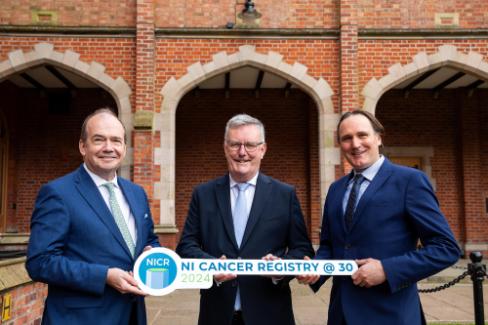Red flag referral & screening routes shown to have better cancer survival rates in Northern Ireland
A new report by the Northern Ireland Cancer Registry (NICR) at Queen’s has found red flag referral or screening routes provided patients with earlier cancer diagnosis & have been shown to provide better survival rates for people in Northern Ireland.

Pictured front is Ms Helen Mitchell, Statistician at the Northern Ireland Cancer Registry at Queen's University Belfast with Director of the Northern Ireland Cancer Registry, Dr Damien Bennett. Pictures by Jonathan Jones Photography.
The “Routes to Diagnosis” report has been presented today at an event at Queen’s which celebrates 30 years of the NICR.
The research, conducted on patients diagnosed between 2018 to 2020, was commissioned by the Department of Health under Action 5 of the Cancer Strategy.
The NICR is based in the Centre for Public Health at Queen's University and is funded by the Public Health Agency for Northern Ireland. Today’s event marks 30 years of the registry which has provided key official statistics on cancer incidence, prevalence, and survival in Northern Ireland, as well as data, intelligence and insights to help inform decision making about cancer services.
The NICR implemented the Routes to Diagnosis report, first developed in England, to detail the pathway a patient follows to their cancer diagnosis and examine associated patient, demographic and organisational factors. To do this, it linked multiple health datasets to categorise pathways to a patient’s cancer diagnosis.
The report shows a strong relationship between a patient’s route to diagnosis and how advanced their cancer was at diagnosis. It found higher proportions of patients diagnosed with early-stage disease came via screening or red-flag referral routes, with a higher proportion with advanced (late-stage) disease coming from emergency presentation.
The data also shows that one-year survival was 87% for those diagnosed via red-flag referral compared to only 42% for those diagnosed following emergency presentation, and over 98% of those diagnosed via screening are alive one year following diagnosis.
It also found that the two years from diagnosis to survival ranged from 33% for those diagnosed via an emergency presentation route to 80% for those diagnosed via a red-flag referral route.
The Health Minister Mike Nesbitt said: “Reporting on the trends in cancer incidence and survival is an important step in helping to shape the future delivery of cancer in Northern Ireland. It is therefore essential that we prioritise investment in this important work and other priority activities identified through the Northern Ireland Cancer Strategy. This will ensure that these important activities can continue to deliver improved outcomes for cancer patients and those families impacted by such a diagnosis.”
The Chief Medical Officer Professor Sir Michael McBride,The Health Minister Mike Nesbitt and Dr Damien Bennett, Director of the Northern Ireland Cancer Registry (NICR) at Queen’s University Belfast, pictured today at the report launch.
Speaking at the event, Dr Damien Bennett, Director of the Northern Ireland Cancer Registry at Queen’s University Belfast, said: “This data is important because a diagnosis of late-stage (advanced) cancer translates to poorer survival.
“We also show the survival benefit associated with certain routes to diagnosis compared to others and found a higher proportion of older patients and those from more deprived areas were diagnosed following emergency presentation.
“Continued support and development of cancer screening programmes, encouragement of cancer awareness among the public and efforts to reduce emergency presentations will help increase cancers diagnosed via screening and red flag referral routes.”
The Chief Medical Officer Professor Sir Michael McBride, who is addressing the conference, said: “An aim of the Cancer Strategy for Northern Ireland, launched in March 2022, was to establish Routes to Diagnosis reporting and analysis and this report by NICR delivers this. This project can be used to monitor efforts to improve earlier diagnosis and the impact of changes in cancer pathways and healthcare systems on a patient’s route to diagnosis. It also gives us vital intelligence in shaping future services.”
Dr Bennett concluded: “For three decades we have been developing cancer data supporting health outcomes in Northern Ireland and today’s Routes to Diagnosis report shows the need for continued investment to helps us better understand cancer outcomes and enables us to inform policies that will positively impact cancer patients in the future.”
Media
Media inquiries to Sian Devlin at s.devlin@qub.ac.uk
